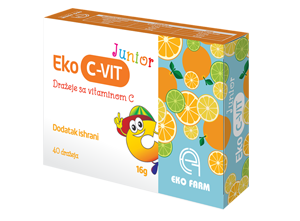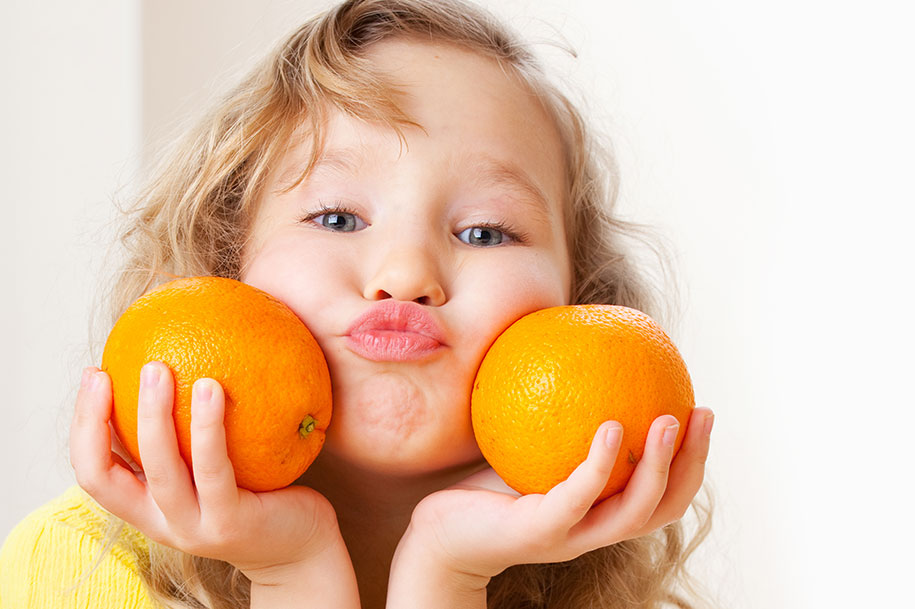Vitamin C or L-ascorbic acid is a water-soluble vitamin that is necessary for children’s normal growth and development. It is required for crucial metabolic pathways and biosynthesis of collagen, which is the main structural protein of various connective tissues. This is especially important for children and adolescents, who’s tendons, ligaments, cartilage, bones, skin, blood vessels, corneas and dentin are all growing rapidly and are in higher need for “building material” in order to develop properly. Adequate intake of vitamin C can help improve components of children’s fragile immune system and shorten the symptoms and duration of upper respiratory tract infections (URTI), which are the most common ones during the winter months. It also affects the wound and fracture healing process in a positive way, by reducing recovery time, which is particularly beneficial for small children, who are at constant risk of hurting themselves. Sufficient amounts of Vitamin C in children’s diet protect them from developing a fairly common iron deficiency anemia, by enhancing non-haem iron absorption.
Natural sources of vitamin C
Vitamin C is an essential nutrient, which means that it cannot be synthesized by the children’s body. Therefore, it must be provided continuously through a healthy, well-balanced diet. Raw fruits and vegetables are the best natural sources of vitamin C. Foods containing highest amounts of vitamin C are shown in Table 1.
Table 1: Different content of vitamin C in various fruits and vegetables
| fruits/vegetables | portion size | vitamin C content |
| papaya | 1/2 medium fruit | 94 mg |
| kiwifruit | 1 large fruit | 84 mg |
| orange | 1 medium fruit | 71 mg |
| orange juice | 1/2 juice cup** | 50 mg |
| grapefruit | 1/2 medium fruit | 43 mg |
| mandarin | 1 medium fruit | 22 mg |
| strawberries | 3 medium fruits | 21 mg |
| raspberries | 1/2 cup* | 16 mg |
| pineapple | 1/2 cup | 45 mg |
| broccoli | 1/2 cup* | 54 mg |
| red peppers | 1/2 cup* | 120 mg |
| red cabbage | 1/2 cup* | 27 mg |
| brussels sprouts | 4 sprouts | 45 mg |
| cauliflower | 1/2 cup* | 27 mg |
| potato | 1 medium potato | 20 mg |
| tomato | 1 medium tomato | 16 mg |
* – cup is the amount of fruits/vegetables equivalent to a volume of 250ml
** – juice cup is equivalent to a volume of 250ml
Vitamin C is highly labile and its content in foods can be affected by cooking, prolonged storage, oxygen and light exposure. That is why most of the fruits and vegetables from Table 1 should be offered to children raw, rather than processed. Broccoli, brussels sprouts, cauliflower and potato, on the other hand, are better eaten cooked, since they contain higher amounts of vitamin C that way. It is highly recommended to use the cooking water, instead of throwing it away, because it is rich in vitamin C and other water-soluble vitamins.
Recommendations
Recommendations for vitamin C intake have been set by various national agencies. According to the U.S. Food and Nutrition Board of the Institute of Medicine, Recommended Dietary Allowances (RDAs) for vitamin C represent the average daily level of intake, that is sufficient to meet the nutrient requirements of nearly all (97%–98%) healthy children. Table 2 shows the current RDAs for vitamin C for children aged from 1-18 years, as well as Tolerable Upper Intake Levels (ULs) for vitamin C, which represent the maximum daily intake that is unlikely to cause adverse health effects.
Table 2: RDA levels and UL levels for vitamin C depending on the child’s age
| age (years) | RDA (mg) | UL (mg) | |
| male | female | ||
| 1-3 | 15 | 15 | 400 |
| 4-8 | 25 | 25 | 650 |
| 9-13 | 45 | 45 | 1200 |
| 14-18 | 75 | 65 | 1800 |
Are dietary supplements with vitamin C recommended for children?
All parents know that there is a time in children’s development when they begin to reject new foods and tastes and become what is often called picky eaters. This usually results in parents getting worried and frustrated and children eating a limited variety of foods. Good news is that this is, in most cases, a passing phase and it can be overcome by constant, patient encouraging and exposing children to foods they otherwise tend to reject . Most of the healthy children have normal levels of vitamin C, even if they refuse to eat a wide variety of fruits and vegetables. That is due to the large number of foods and beverages that are fortified with this vitamin (breads, grains, cereal, fruit juices, dairy products) and are included in everyday children’s diet. However, there are cases where children, unfortunately, do not receive the necessary amount of vitamin C, when it is justified to add dietary supplements to a healthy diet, after consulting a pediatrician. Some examples include children who are underweight, who are on resricted diets, or have illnesses that put them at risk for developing vitamin C deficiency. There is evidence that vitamin C affects the children’s immune system in a positive way and shortens the duration of respiratory infections, which is another indication for the use of vitamin C dietary supplements, especially during cold and flu season. It is important to know that dietary supplements should be used carefully, under a healthcare provider supervision, following the instructions for use. In addition, parents should keep them out of children’s reach and make sure they understand it clear that they aren’t sweets and candy.
Possible side effects
Vitamin C is generally regarded as safe, thanks to its water solubility. It means that every excess dietary intake of vitamin C will be excreted in the urine and eliminated from the children’s body. However, toxic levels of vitamin C can be reached through high intake of fortified foods and dietary supplements, which is why it is very important to strictly follow the recommended dosing guidelines. Possible side effects in children include diarrhea, nausea, vomiting, abdominal cramps, heartburn, skin rashes and headache.
by: mr ph Iva Majstorović, posted on December 4, 2014
References
1. Dietitians of Canada – Food Sources of Vitamin C
http://www.dietitians.ca/Nutrition-Resources-A-Z/Factsheets/Vitamins/Food-Sources-of-Vitamin-C.aspx
2.Vitamin C in your child’s diet – Baby Center
http://www.babycenter.com/0_vitamin-c-in-your-childs-diet_10324695.bc
3. Vitamin and mineral supplementation in kids. American Medical Association.
http://archpedi.jamanetwork.com/article.aspx?volume=163&issue=2&page=192
4. Recommended Dietary Allowance (RDA) for vitamin C
http://lpi.oregonstate.edu/infocenter/vitamins/vitaminC/index.html
5. The U.S. Department of Agriculture’s (USDA’s) Nutrient Database
http://ndb.nal.usda.gov/
 Eko C-Vit junior is a dietary supplement based on vitamin C, that is recommended for preschool, and school-age children. It contains the recommended vitamin C dose of 50 mg, which meets the children’s daily needs for this vitamin. Tablets are coated with sugar, and 100% natural orange flavor, which makes them easily acceptable for the kids – even for those with the most demanding taste.
Eko C-Vit junior is a dietary supplement based on vitamin C, that is recommended for preschool, and school-age children. It contains the recommended vitamin C dose of 50 mg, which meets the children’s daily needs for this vitamin. Tablets are coated with sugar, and 100% natural orange flavor, which makes them easily acceptable for the kids – even for those with the most demanding taste.
